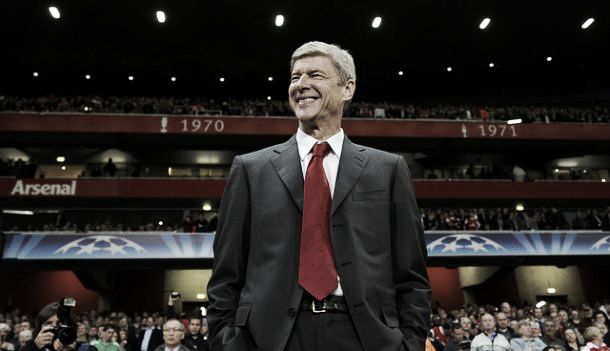Over the past nine years, Arsenal, once known as one of the best in Europe, have failed to win a single trophy, only making it into three finals in that time (2006 Champions League, 2007 League Cup and 2011 League Cup). Throughout this time, Arsenal, and Arsène Wenger in particular, have come under scrutiny for their consistent underachievement, slipping away from title contention to Champions League qualification struggle from season to season.
Since that famous FA Cup win of 2005, Arsenal have not finished in the top two positions, and failed to make an impact in Europe, with 2005-06 being an exception. The loss of top quality players due to the lack of trophies, along with the building and debt repayment of the Emirates Stadium, has seen the Gunners lack the means of replacing players such as Samir Nasri, Robin van Persie, and possibly the most key player: Patrick Vieira. With football becoming an ever-developing sport, which has seen key positions change, the physicality of players increase, as well as the tactics and players necessary to break teams down, the real question is: Is Wenger getting it all wrong?
Below are two images of the Arsenal side of 2004 and the Arsenal side of 2014, compared to see the change in formations, as well as the style of players that Wenger has gone for over the past ten years, and how that has affected the Gunners.


The most obvious change that Wenger has made is the change in formation, switching from a classic 4-4-2 to a more modern and conventional 4-2-3-1. The use of three creative attacking midfielders with a poacher-type forward is one that works effectively enough for Arsenal, with Cazorla and Özil providing the main spark, while Giroud plays as a lone striker, hoping to put away any key passes aimed toward him. Picking a striker of such presence in the area, not only down to his height, but also his strength, is a decision that leaves most defenders struggling to cope.
Wenger has also signed new players that are comfortable being played in other areas of the pitch. Players with pace, such as Theo Walcott and Kieran Gibbs are rare, and that key attribute has allowed them to become more versatile and adapt to new positions. In the past two or three seasons, on many occasions, particularly in the 2012-13 season, Walcott could be played as a main striker, filling the void that Olivier Giroud would leave if he were not to play. The pace of Gibbs has also enabled him to play off of the left-back, and move into more of an attacking position in various games. Both Arsenal full-backs (Gibbs and Sagna) have a tendency to attack the flanks during games, creating chances at one end, whilst preventing them at the other.
One key attribute that has changed over the past 10 or so years is the physical strength of players. In the 2004 squad, Arsenal had the likes of Patrick Vieira, Gilberto Silva and Sol Campbell. All three were strong enough to knock opposition players off the ball and to win back possession whenever necessary. The Arsenal squad of current time, however, lacks players with this trait, which, given the physicality of the game today, shouts signals at Wenger’s player and tactic selections. The decision to play with two holding midfielders is one that has changed the way Arsenal play, making them more defensive whilst still dominating the centre of the field. These two holding midfielders, whether they be Mathieu Flamini, Jack Wilshere, Mikel Arteta or Aaron Ramsey, all do not have such ability that everybody was used to seeing with an Arsenal team. Their lack of physical presence is worrying in these current times, as it can, and on certain occasions, will see Arsenal being dominated by other teams in the midfield department.
Another notable change is the lack of a complete striker, or second striker, like the Bergkamp of the 2004 Arsenal side. The current Arsenal team is threadbare in the striker department, with the likes of Park-Chu Young and Nicklas Bendtner being frozen out of the side, and Yaya Sanogo and Chuba Akpom having inadequate experience to be able to make a big enough impact in such competitions that the Gunners partake in.
So what do Arsenal need to get themselves back to the glory days of winning Premier League titles and cup competitions?
The main thing for Arsenal to bring back the past feats is to purchase players that fit the qualities needed to boost the squad. A striker that can either play in front of, behind or even replace Giroud is key. A player like Mario Mandzukic, who has the combination of strength, height, as well as fantastic finishing technique, is just one player that could be suggested.
Another position that Arsenal need to look to fill is that which was left by the departure of Patrick Vieira: a central midfielder, as well as a leader. Over the past five or six years, various Arsenal captains have departed the club, such as William Gallas, Cesc Fabregas, and perhaps most notably, Robin van Persie. However, none of the current roster have as much passion and belief, as well as a winning mentality game in, game out as players like Vieira or Keown ever did. The current club captain, Thomas Vermaelen, rarely gets a look-in when the teams are announced for each game. The armband, in most cases is handed over to Mikel Arteta or Per Mertesacker, should the former be absent. Players who would fit the bill are players such as Yaya Toure and Sergio Busquets.
All in all, the beautiful game is an ever-changing sport, with new skills being needed all the time to progress as far as possible. But whilst the sport is quickly developing, Arsène Wenger and his tactics are not. If things are not changed soon enough, it is almost inevitable that the Gunners will continue to lose track with Europe’s elite, slipping further and further down the rankings as they go.










































